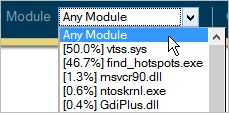Use the Filter toolbar to filter the data displayed in the grid or Timeline pane. Filtering settings applied to the currently opened result are saved for the whole project and automatically applied to the subsequent results in this project.
Use This |
To Do This |
|---|---|
Metric filter |
Mouse over the
By default, you see 100% of all metric data collected in the result. Metric values vary with a viewpoint and analysis type. For example, for the Hardware Issues viewpoint available for the Advanced Hotspots analysis result there are Clockticks and Instructions Retired event metrics available, where the Clockticks event is selected by default. Open any filtering drop-down menu to see the percentage of the Clockticks event count each module/process/thread introduces into the overall Clockticks event count for the result:
If you select a program unit in the filtering drop-down menu, your grid and Timeline view will be filtered out to display data for this particular program unit. For example, if you select the find_hotspots module introducing 46.7% of the Clockticks event count, the result data will display statistics for this module only and the Filter bar provides an indicator that only 46.7% of the Clockticks data is currently displayed:
|
Module filter |
Select a module to filter the collected data by its contribution. All data related to other modules is hidden. By default [Any Module] is selected. This option does not filter any data. |
Thread filter |
Select a thread to filter the collected data by its contribution. All data related to other threads is hidden. By default [Any Thread] is selected. This option does not filter any data. |
Process filter |
Select a process to filter the collected data by its contribution. All data related to other processes is hidden. By default [Any Process] is selected. This option does not filter any data. |
Thread Concurrency filter |
Select a thread concurrency level to filter the collected data by its contribution. All data related to other concurrency levels is hidden. By default [Any Thread Concurrency] is selected. This option does not filter any data. This filter is applied to the Hotspots by Thread Concurrency and Locks and Waits viewpoints for user-mode sampling and tracing analysis results. |
Utilization filter |
Filter data in the grid by available CPU time utilization modes. This filter is applied to the Hotspots by CPU Usage viewpoint for the user-mode sampling and tracing analysis results. |
Sleep States filter |
Select a sleep state (C0 - Cn) to filter the collected data by its contribution. The deeper the sleep state of the CPU is, the greater power savings are. This filter is available for Energy analysis results only. |
Wake-up Reason filter |
Filter data by types of the objects that force the processor to wake up. Possible wake-up reasons are timer, interrupt, IPI, and so on. This filter is available for Energy analysis results only. |
Timer Type filter |
Filter data by type of the timers that force the processor to wake up. Choose between User and Kernel Timers. This filter is available for Energy analysis results only. |
|
Remove all filters and view all the available data. |
Inline Mode option |
Enable/Disable displaying performance data per inline functions. This option is supported if you compile your code using
|
Call Stack Mode option |
Select whether to show system functions:
|
Loop Mode option |
Select a type of hierarchy to display loop data in the grid. The following types are available:
|
Note
If you applied filters available on the Filter bar to the data already filtered with the Filter In/Out by Selection context menu options, all filters are combined and applied simultaneously.
 Filter icon to enable the metric drop-down menu and
select a filtering metric:
Filter icon to enable the metric drop-down menu and
select a filtering metric:



 Clear Filter icon
Clear Filter icon